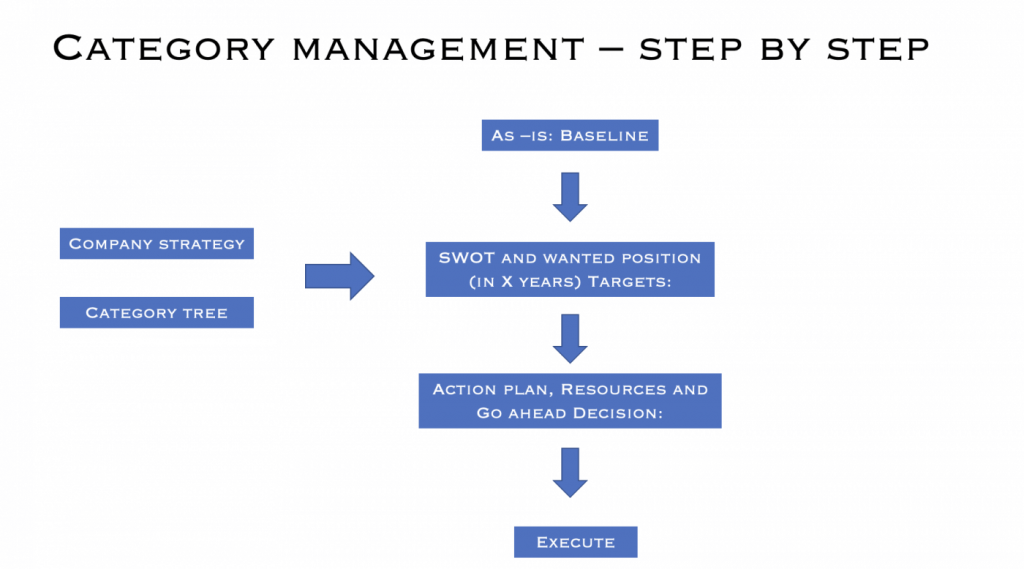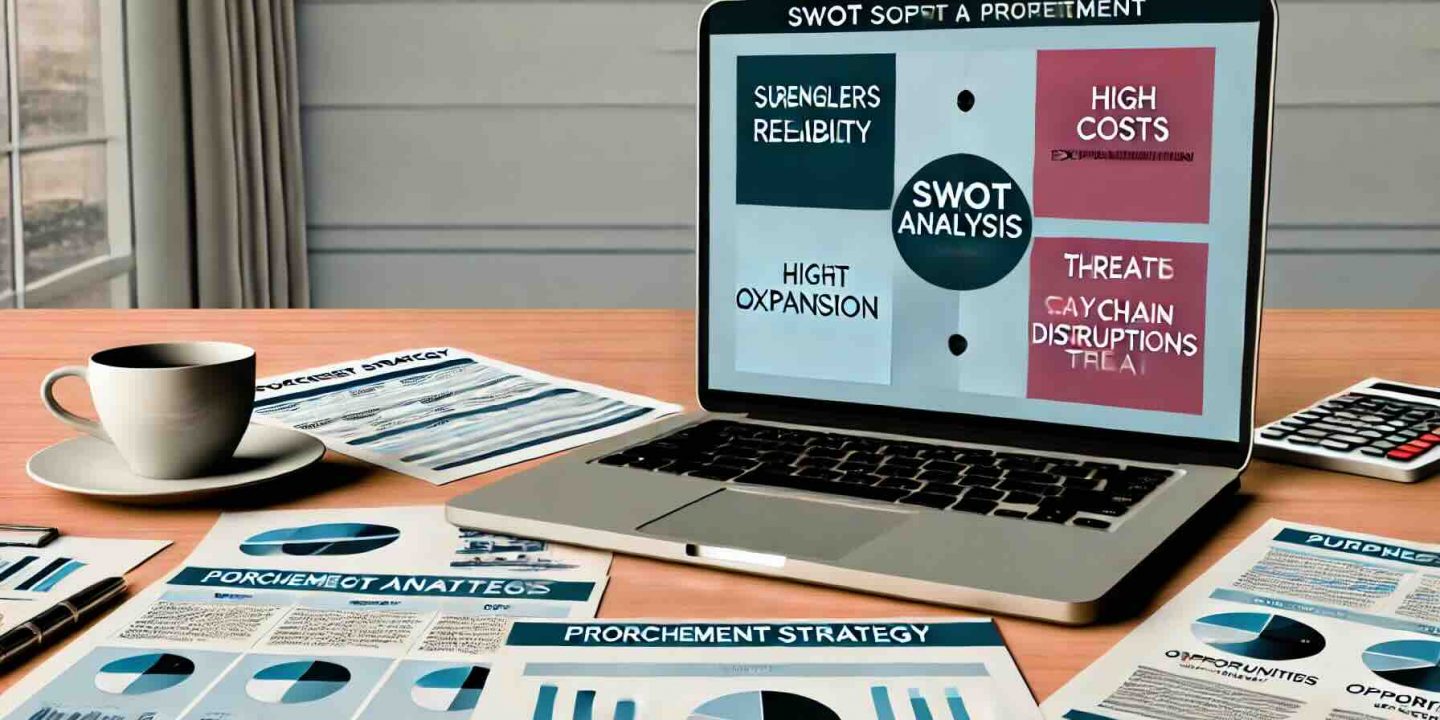By utilizing the SWOT Method to Enhance Procurement Category Strategy you get a better understanding about your Category’s road ahead. Learn how to use the SWOT method as a critical part of developing a procurement category strategy, and explore a real-life example to optimize your supply chain management.
Content…
SWOT Method as part of a Category Strategy
The world of procurement is evolving rapidly, and businesses must adapt to stay competitive. A robust procurement category strategy is essential to optimize supply chain management, reduce costs, and increase overall efficiency. One powerful tool that can help you develop a successful category strategy is the SWOT method. This blog post will guide you through using the SWOT method, its benefits, and provide a real-life example to give you a clear understanding of its practical application.
What is the SWOT Method?
SWOT stands for Strengths, Weaknesses, Opportunities, and Threats. It is a strategic analysis tool that allows you to assess the internal and external factors affecting your procurement category strategy. By evaluating these factors, you can identify areas for improvement and capitalize on opportunities for growth.
Using the SWOT Method to Enhance Procurement Category Strategy
Strengths: Begin by identifying the strengths within your procurement category. This can include skilled procurement staff, established supplier relationships, or efficient procurement processes. Recognizing these strengths will help you leverage them to improve your overall procurement strategy.
Weaknesses: Next, identify the weaknesses within your procurement category, such as lack of supplier diversity, poor contract management, or inadequate cost control. Addressing these weaknesses will enable you to make informed decisions that bolster your procurement strategy.
Opportunities: Evaluate external opportunities that can contribute to the growth of your procurement category, such as technological advancements, industry trends, or untapped markets. Capitalizing on these opportunities can provide a competitive edge and drive overall business success.
Threats: Lastly, identify external threats that could negatively impact your procurement category, such as changing regulations, economic downturns, or increased competition. By understanding these threats, you can develop contingency plans to mitigate risks and ensure the resilience of your procurement strategy.
Example: SWOT Analysis for a Procurement Category Strategy in Electronics Manufacturing
Strengths:
- Long-term relationships with key suppliers.
- Effective negotiation strategies leading to cost savings.
- Skilled procurement team with industry expertise.
Weaknesses:
- Limited supplier diversity, causing dependency on a few suppliers.
- Inefficient contract management processes.
- Insufficient focus on sustainability and ethical sourcing.
Opportunities:
- Integration of digital procurement tools to improve efficiency.
- Expansion into emerging markets for new supplier sources.
- Collaboration with suppliers for joint innovation projects.
Threats:
- Potential supply chain disruptions due to geopolitical tensions.
- Increasing global competition in the electronics manufacturing industry.
- Rapidly changing regulations related to environmental sustainability and material sourcing.
Pros of the SWOT Model
- Comprehensive Overview: SWOT offers a balanced view of internal and external factors impacting the organization. This helps in understanding both the current position and potential future scenarios.
- Simplicity and Flexibility: The model is straightforward and can be applied to a wide range of situations, from business strategies to project management and personal development.
- Facilitates Strategic Planning: It helps in identifying the areas where the organization can capitalize on its strengths, improve weaknesses, exploit opportunities, and mitigate threats.
- Promotes Team Discussion: Conducting a SWOT analysis can encourage open discussion among team members, leading to a more thorough and insightful assessment.
Cons of the SWOT Model
- Subjectivity: The analysis can be highly subjective. Different people may have varying perspectives on what constitutes a strength, weakness, opportunity, or threat.
- Lack of Prioritization: SWOT doesn’t inherently prioritize elements. Without proper analysis, the most significant factors may not be clearly identified.
- No Direct Action Plan: While SWOT helps in identifying various factors, it doesn’t provide a direct strategy or action plan to address them.
- Static Analysis: It often presents a snapshot in time and may not account for the dynamic nature of business environments.
The Need for Cross-Functional Input
For a SWOT analysis to be truly effective, especially in the context of procurement and category management, it requires input from various functional areas within the organization. Here’s why:
- Diverse Perspectives: Different departments bring unique insights. For example, marketing might identify opportunities and threats in market trends, while finance might highlight strengths and weaknesses in budgeting and cost structures.
- Comprehensive Understanding: Cross-functional involvement ensures a more holistic understanding of the business environment, leading to more accurate and actionable SWOT outcomes.
- Identification of Synergies and Conflicts: Input from various functions can help identify synergies and conflicts between departments, influencing the strategic direction.
- Enhanced Buy-in: Involving multiple departments fosters a sense of ownership and acceptance of the strategic plan derived from the SWOT analysis.
Summary: SWOT Method to Enhance Procurement Category Strategy
The SWOT method is an invaluable tool for developing a well-rounded procurement category strategy. By evaluating your organization’s strengths, weaknesses, opportunities, and threats, you can make informed decisions that optimize your supply chain management, mitigate risks, and drive long-term success. Remember to regularly revisit and update your SWOT analysis to ensure your procurement strategy remains relevant and adaptive to changing market conditions. While the SWOT model is an invaluable tool in category management and strategic procurement, its effectiveness is significantly enhanced by incorporating diverse, cross-functional insights. This approach mitigates the model’s inherent limitations and leads to a more robust, actionable strategy that aligns with the organization’s overall objectives.

Learn more about category Management in Learn How to Source’s course Category Management – how to get started. This advanced level course will help you with the first steps when implementing Category Management. The course includes a broader explanation of Category management, the content of a first version of a Category strategy and key finding (checklists).
Extra: Planning and executing a SWOT
Planning and executing a SWOT (Strengths, Weaknesses, Opportunities, Threats) workshop involves careful preparation, engagement of the right stakeholders, and structured facilitation to ensure meaningful outcomes. Here’s a guide to help you plan and execute a successful SWOT workshop:
1. Pre-Workshop Planning
Define Objectives:
- Clearly define what you want to achieve with the SWOT analysis. This could be understanding the competitive landscape, exploring new market opportunities, or assessing a project’s viability.
Identify Participants:
- Select a diverse group of participants from various departments or areas of expertise. Cross-functional representation ensures a comprehensive view.
Prepare Materials:
- Create a workshop agenda, SWOT templates (one for each group or participant), and any background material necessary for the discussion.
- Ensure you have tools for collaboration, like whiteboards, markers, sticky notes, or digital collaboration tools if conducting the workshop virtually.
Communicate with Participants:
- Send invites well in advance, including the workshop agenda, objectives, and any pre-read material.
- Encourage participants to come prepared with ideas and insights.
2. Workshop Execution
Introduction and Setting the Stage:
- Start by outlining the objectives of the workshop.
- Briefly explain the SWOT framework for any participants who might be unfamiliar with it.
- Breaking Down into Groups:
- Divide participants into smaller groups for a more focused and manageable discussion.
- Assign each group to focus on one element of SWOT, or have each group work on the entire SWOT matrix, depending on the size and scope of the workshop.
Facilitating the Discussion:
- Encourage open and honest discussion. Remind participants that the goal is to gain a realistic view of the organization’s position.
- Ask probing questions to guide the conversation and ensure all aspects are covered.
- Keep time to ensure that all areas of SWOT receive equal attention.
Collation and Group Sharing:
- Have each group present their findings. This can be done by having a spokesperson for each group or by rotating around the SWOT matrix.
- Encourage constructive feedback and discussion among the groups.
3. Post-Workshop Activities
Documenting the Outcomes:
- Compile the information gathered into a comprehensive SWOT matrix.
- Ensure that the final document is clear and structured.
Analysis and Strategic Planning:
- Analyze the SWOT matrix to identify key themes, strategic imperatives, and potential action plans.
- Consider conducting a follow-up session to delve deeper into how to leverage strengths and opportunities and address weaknesses and threats.
Sharing the Results:
- Distribute the final SWOT analysis to all participants and relevant stakeholders.
- Communicate how the insights will be used for strategic planning and decision-making.
Follow-Up:
- Plan for periodic reviews of the SWOT analysis to ensure that it remains relevant and to assess progress on any actions undertaken.
Conclusion
A well-planned and executed SWOT workshop can provide invaluable insights for strategic decision-making. It’s essential to engage participants from diverse backgrounds, facilitate open discussion, and follow through with a clear action plan based on the workshop’s findings.
Hope you have learned how to use to SWOT Method to Enhance Procurement Category Strategy.
Information about LHTS Online Procurement courses in Swedish.
Note: Illustrating picture created by DALL-E on September 14, 2024.
